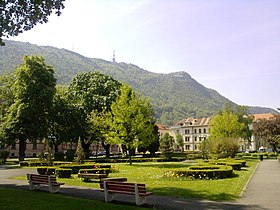Tâmpa, Brașov
| Tâmpa | |
|---|---|
 |
|
| Highest point | |
| Elevation | 960 m (3,150 ft) |
| Prominence | ~350 m |
| Coordinates | 45°38′N 25°35′E / 45.633°N 25.583°E |
| Geography | |
| Location | Braşov, Romania |
| Parent range | Curvature Carpathians, Eastern Carpathians |
Tâmpa (German: Zinne, or Kapellenberg; Hungarian: Cenk; Latin: Mons Cinum) is a mountain, part of the Postăvarul Massif, located in the southern part of the Eastern Carpathians (alternatively categorized as in the Curvature Carpathians) and almost entirely surrounded by the city of Braşov. Its elevation is 960 m (995 m according to some sources), almost 400 m above the city.
The mountain is mostly made up of limestone formations, having risen up gradually from the Earth's crust.
Most of the mountain (1.5 km²) is a declared nature reserve, due to the rare animal species (bears, birds, butterflies—35% of Romanian butterfly species) and plant species (a rare Liverleaf variety, Transylvanian Windgrass) that are found there. A number of routes to the summit exist: there are 25 winding paths cut in 1837 by Brașov's forest administration; Gabony's stairs; the Knights' road, dating to the days of the Brașovia citadel; and an auto road. A cable car makes the journey between the cabin/restaurant Casa Pădurarului at the base of the mountain to the Restaurantul Panoramic, on its crest, in under three minutes. The view from the summit is spectacular, offering a panoramic view of the city; on a clear day, the entire Burzenland is visible.
The etymology of the word Tâmpa, a name shared by several mountains, has been much discussed among Romanian linguists. Nicolae Drăganu started from the observation that Albanian and southern Italian dialects as well as Catalan have very similar words meaning "boulder", "hillock" or "rocky incline". He then proposed a pre-Roman, Thracian origin (*timpa), meaning "strait, mountain valley" and "mountain, rocky mountain". He was unclear as to whether the word entered Romanian directly or through Latin. Constantin Diculescu accepted the theory without important changes, pointing out that τὑμφα means "hillock" in Doric Greek.
...
Wikipedia
